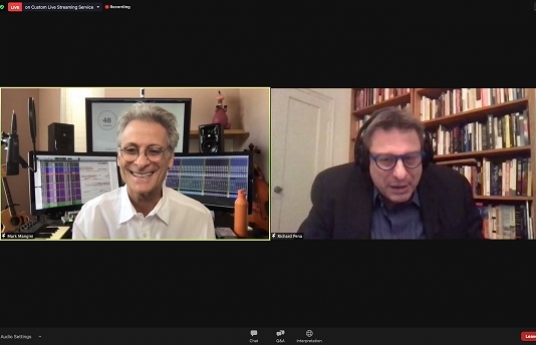خبير قمرة مارك مانجيني لصنّاع الأفلام الواعدين المشاركين في قمرة: الابتكار ضروري لكسر القوالب النمطيّة للأصوات وتعزيز واقعيتها
15 مارس 2021

- في ندوة سينمائية أقيمت ضمن فعاليات قمرة: مصمم الصوت الفائز بجائزة الأوسكار والمُرشح لها خمس مرات مارك مانجيني يناقش أهمية الصوت في بلورة قدرة الأفلام على التعبير الإبداعي الشامل
الدوحة، قطر – 15 مارس 2021: احتل موضوع تصميم الصوت في الأعمال السينمائي صدارة النقاش في ندوة سينمائية أقيمت ضمن فعاليات قمرة وتحدّث فيها مصمم الصوت الفائز بجائزة الأوسكار والمُرشح لها خمس مرات مارك مانجيني.
عُقدت الندوة عبر الإنترنت ضمن فعاليات قمرة 2021، الملتقى السنوي الذي تعقده مؤسسة الدوحة للأفلام لاحتضان المواهب السينمائية العربية، وأدارها ريتشارد بنيا، مدير البرامج بجمعية الفيلم في مركز لينكولن ومدير مهرجان نيويورك السينمائي في الفترة من 1988 وحتى 2012. وعلى مدار الندوة، تحدّث مارك مانجيني بصراحة عن مشواره الفني وعملية تصميم الصوت في أعماله السينمائية التي تشمل: “بليد رانر 2049” (2017)، “ستار تريك الرابع: رحلة إلى الوطن” (1986)، “غريملنز” (1984) وغيرها.
وخلال الندوة، استعرض مانجيني عملية ابتكاره للأصوات وكيفية جمعه لها واستلهامه لها من خلال ما يحيط به من عناصر لا يخلو بعضها من عناصر الغذاء التي تُصدر مؤثرات صوتية قد لا تخطر للكثيرين على بال. وعن تبنيه للوسائل التكنولوجية الجديدة، قال مانجيني: “لا شك أن ظهور وسائل التسجيل والمونتاج الرقمي قد أحدث ثورةً حقيقية في صناعة تصميم الصوت، وعن نفسي، فإنني أصنّف نفسي من قدماء المهنة إلا أنني استطعت التأقلم وإعادة بلورة مهاراتي وتطويرها. وعلى الرغم من أنني من عشاق الأقراص الصلبة والقدرة على إعادة تشغيل الصوت وتجربته، إلا أن الانتقال للأسلوب الرقمي في تسجيل الصوت، والذي يُعد أبرز تغيير طرأ على صناعة تصميم الصوت، قد أثّر بشكل واضح ليس فقط على آليّات إنتاج الصوت بل وأيضاً على آليّات عرض الصوت للأعمال السينمائية”.
ونوّه مانجيني إلى الدور الحيوي الذي يلعبه الصوت في توصيل نبض القصة في أي عمل سينمائي، من خلال إزالة الحواجز التي قد تمنع المتلقي من تصديق القصة. وعن ذلك، قال مانجيني: “كمصمم صوت، فإنك تعلم أنك تصنع مؤثرات صوتية خصيصاً من أجل العمل السينمائي وأنها ليست فعليّة أو مستمدة من مواقف حقيقية، إلا أن مهارتك تكمن في دعم اقتناع صانع العمل بالقصة وصناعة أصوات تقترب من الحقيقة بأكبر قدر ممكن. ومع التطوّر التكنولوجي الذي بتنا نشهده، فإننا نمتلك الأدوات التي تمكّننا من ابتكار تصورات ومؤثرات موازية للواقع، سواء كانت مصطنعة أم لا”.
وعن هذه التصوّرات الصوتية البديلة، أكد مانجيني أنه كان دائم السعي نحو التجديد والابتكار في عملية صناعة الأصوات، ومن هذا المنطلق فقد كسر القوالب التقليدية لتصميم الصوت بشكل منعزل عن الفيلم في مرحلة ما بعد الإنتاج، وشدّد على أهمية عمل مصمم الصوت عن قرب مع صنّاع العمل ابتداءً من مرحلة ما قبل الإنتاج. وعن ذلك صرّح مانجيني: “لا يجب إغفال عملية تصميم الصوت في كل مرحلة من مراحل إنتاج العمل السينمائي، إذ يمكن للصوت أن يُستخدم كأداة فعّالة لسرد القصص بشكل يخاطب الجمهور مباشرةً ليكون بذلك مُكملاً للحوار أو النقاش بين شخصيات العمل، فإذا استطعت – كمشاهد – أن تسمع ما يحاول أحدهم إخبارك إياه، فإن هذا مؤشر على الإنجاز المُتقن للعمل”.
وعن تعاونه مع الكُتاب، والذين يتواصلون معه عند مرورهم بفترة نضوب إبداعي، قال مانجيني: “يسألني الكثير من الكُتّاب عمّا إذا كان بإمكانهم استخدام الصوت لتجاوز ذلك النضوب الإبداعي بصورة أكثر جمالية مقارنةً بالكلمات“، مشيراً أن دوره كمصمم صوت قد امتد ليشمل إسهامات محورية في مرحلة المونتاج، إذ يتداخل ويتكامل عمله مع القائمين على هذه المرحلة للخروج بأفضل شكل ممكن للعمل السينمائي.
وقد سلّط مانجيني الضوء على عمله في تصميم أصوات مجموعة من أهم الأعمال السينمائية ومنها “بليد رانر 2049” الذي تطّلب منه ابتكار صوت مميز يتناسب مع أجواء هذا العمل من خلال مزج الموسيقى والصوت بصورة لا تجعلهما في موضع تنافس بين بعضهما البعض. وقد استرجع ذكريات عمله مع المخرج دينيس فيلنوف خلال العمل، حيث طلب منه إزالة الحواجز بين الصوت والموسيقى، حتى لا يُشتت الجمهور وينشغل بانتقاد هذه العناصر. وقد حلل الاثنان نسخة 1982 من فيلم بليد رانر واستقوا منه الأجواء العامة والأنماط الفنية غير التقليدية التي يزخر بها العمل واحتفظوا بها في الجزء الجديد من الفيلم تقديراً للعمل الأصلي الذي ترك بصمة فنية ملموسة.
وأشار مانجيني إلى امتلاكه لمكتبة صوتية عامرة بأكثر من 60 ألف ملف صوتي، مؤكداً أنه يسعى باستمرار إلى صناعة أصوات تخدم أجواء العمل من خلال مختلف الوسائل غير التقليدية، مثل الاستعانة بساحقات الحديد لتسجيل صوت اصطدام الحديد، ووضع مسجلات الصوت في مزرعة نحل لتسجيل طنين النحل بصورة عفوية، كما تطرّق إلى كيفية الاستفادة من الصمت بالشكل الأمثل في الأعمال السينمائية، ونمط “قمة الهرم” الذي يتّبعه المخرج جورج ميلر، مخرج فيلم “ماد ماكس 2”.
وعن جورج ميلر، قال مانجيني: “أعتبره مخرجاً صاحب رؤية فنية فريدة، وأذكر أنه أثناء إنتاج “ماد ماكس 2“، خصصنا وحدةً ثانية تضم فريقاً لتسجيل الصوت. وفي اجتماعنا الأول، شرح لي أسلوبه المعروف بقمة الهرم، ففي أي لقطة يتم تصويرها، هناك الكثير من التفاصيل المرئية والمسموعة، وتمثلت مهمتي في ابتكار الصوت المُحدد الذي يجب أن يسمعه الجمهور بمعزل عن أية عناصر أخرى في اللقطة”.
وقد نصح مانجيني صناع الأفلام بتجميع أكبر قدر ممكن من الأصوات الحقيقية لتجنب الاعتماد على الأصوات المصطنعة بقدر الإمكان، ومراجعة الأصوات التي صنعوها واللجوء إلى التجديد والابتكار وكسر القوالب النمطية للأصوات وتعزيز واقعيتها.
يذكر أن قائمة خبراء قمرة تضم أيضاً كل من: المصوّر السينمائي المُرشح لجائزتيّ الأوسكار والبافتا فيدون باباميتشيل والمخرج العالمي والذي شاركت أفلامه في العديد من دورات مهرجان كان السينمائي جيمس غراي والمخرجة والكاتبة السينمائية الحائزة على جائزة الأسد الفضي جيسيكا هاوسنر ومن المقرر أن يشاركوا خبراتهم وتجاربهم مع الحضور خلال ندواتهم السينمائية على مدار هذا الأسبوع.
يمكن للجمهور المشاركة في فعاليات قمرة عبر الإنترنت من خلال شراء بطاقة قمرة التي تتيح لهم فرصة حضور عروض أفلام قمرة وجلساته الحوارية. ويمكن للمواطنين والمقيمين في قطر ومنطقة الشرق الأوسط وشمال إفريقيا، وتمنح أولوية قبول الطلبات لمن قدّمها أولاً. يصل سعر بطاقة قمرة إلى 500 ريال قطري، بينما يمكن للطلاب وحاملي بطاقتك إلى الثقافة من هيئة متاحف قطر شراء بطاقة قمرة بسعر مخفض يبلغ 350 ريال قطري.